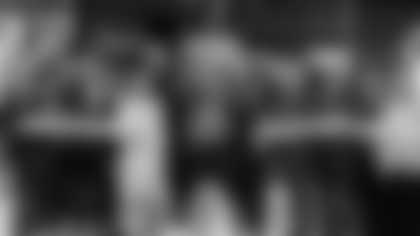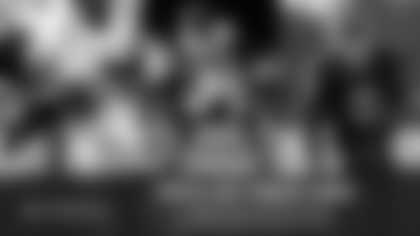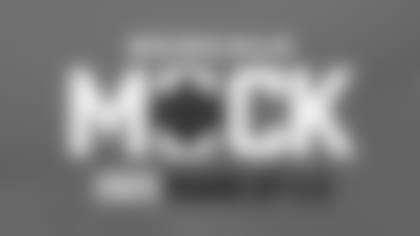INDIANAPOLIS - We are sitting in the first evening workout during the history of the NFL scouting combine and Bengals offensive coordinator Brian Callahan is noting that it has been a long day's journey into night for not only the quarterbacks and wide receivers clumped together on the Lucas Oil Stadium turf.
"Long day. Long day for everybody," says Callahan, who has just emerged from his cave at the Westin Hotel for his first combine duties in about 26 hours. "It didn't change the first couple of days for us offensively because all our interviews were still at night. But the last thing we had yesterday before this was an interview early in the afternoon."
So before trekking over the skywalk to the stadium to take in the workouts, Callahan spent the day as if he were in his Paul Brown Stadium office hunched over his computer. To the accompaniment of Led Zeppelin, Callahan begins building Bengals running back Joe Mixon's Stairway to Heaven as he works on head coach Zac Taylor's master run game list for the spring voluntary practices that don't begin until late May.
"Putting together the packaging of the plays and the formations and giving it to Zac," Callahan says. "We all made a bunch of suggestions and he goes through it and picks out what he likes for the final decision."
Except for killing time with office hours as if it were a Monday Night game on the road, the prime-time combine isn't all that different for the coaches. It's always had the intriguing mix of jovial college reunions, professional trade-show curiosity, more one-liners than Vegas and downright tedium. Look, how many 40-yard dashes can a coach watch? It's like an accountant scanning a W-2 form.
(You've got to have a thick skin around these guys. As Callahan puts the finishing touches on his pro day schedule of campus visits that takes place across the next five weeks, it is suggested a certain reporter should be assigned an interplanetary destination.)
For Callahan, it's even better because it is a father-son reunion. For the past two mornings he's breakfasted with his dad Bill, the highly-regarded offensive line kingpin just hired to coach the trenches in Cleveland. The pair has become quite adept over the past decade they've been in the league together about talking football without talking about their teams, but it is a rather interesting side of AFC North hash browns.
When it is announced that a rather interesting receiver won't run his 40, Callahan immediately sends a biting text to wide receivers coach Bob Bicknell.
"Just giving Bick (grief)," says a smiling Callahan. "It's not Bick's fault the kid isn't running, but give it to him just the same."
Callahan's nickname of "Cali," fits him well. Even though his dad coached in a bunch of spots while he was growing up, his son is California all the way after playing at De La Salle High School in Concord, Calif. He's got an easy, affable L.A. way about him, the kind of guy that attracts old friends around his seat as they watch the workout. That includes a pair of coaches he worked with in Oakland two years ago in tight ends coach Frank Smith, one of Ben Roethlisberger's offensive linemen at Miami of Ohio, and offensive assistant Nick Holz, a guy that goes all the way back to high school in Concord.
"It never stops," Callahan says of Smith's hilarious observations that include a wonderful nickname for guys with short arms. "T. Rex," Smith says. "They're extinct."
Holz doesn't blink when he's introduced to Bicknell, whose mystical, almost zen-like diet saw him drop 70 pounds last season is still the talk of the PBS coaching floor.
"I almost didn't recognize you," Holz says, nodding to Callahan. "You lost a lot of weight. It looks like you gave some to him."
"Relax," Callahan says.
But just under the sandy surf lurks Callahan's laser-intense intellect worthy of a coach's son and a quarterback who never started for the two-time high school national champions yet still won a spot at UCLA as "the ultimate team player," according to his high school coach.
"I think there's a kindred spirit with guys who grew up around the game," says Callahan of coach's sons.
That comes in handy during that one afternoon formal interview lasting the allotted 18 minutes. It just so happens to be with LSU quarterback and Heisman Trophy winner Joe Burrow, the presumptive No. 1 pick of the Bengals and the draft and son of former long-time college assistant Jim Burrow. Callahan likes that schedule.
"It was his only interview of the day. It was his last one," Callahan says. "So he was fresh, more so than he might have been if it had been the last one at night. It was good. More of a conversation. We went back and forth with questions and answers. He's a got a real good feel of their offense. It was a pretty standard quarterback interview. We walked through why he did and didn't do things and he did a really good job."
When Callahan gets over to Lucas, the first thing he does is check into the Bengals stadium suite. Each team has what amounts to a luxury headquarters stocked with food, drink, premium seats and picture-window flat-screen TVs streaming with the live NFL Network feed of the workouts on the floor.
Before Callahan goes down to his field-level seat, he huddles with Mike Potts, the Bengals' director of college scouting. It is to firm up his pro day schedule. He's already set for Baton Rouge on April 3 to see Burrow, for Tuscaloosa on April 9 to see Alabama's Tua Tagovailoa and later this month for Eugene, Ore., to see Oregon's Justin Herbert. He'll also visit a bunch of wide receivers, but he wants to make sure he sees the top three quarterbacks in the draft throw live. He says all three are top five worthy.
When the workouts start with the announcement that Burrow won't work because of choice (complete with a shot of Taylor on the Network feed in the suite) and Tua can't go because of medical (hip), Callahan shrugs. No big deal. He'd rather seem them at their pro day throwing to their own receivers, anyway.
"You have to do your homework on all those top guys," Callahan says. "You don't know what's going to happen. You don't know what's going to unfold. Crazy stuff can happen in the draft. Say someone does offer you a bunch of picks. You have to have done enough homework to feel good about making that decision. You can't go into it set on doing just one thing."
After he leaves Potts, Callahan settles into his seat several rows up from about the two-yard line. He's got his phone to check on the 40-yard times (as well as a great picture of his four-year-old daughter dancing), but no paper.
The only time he takes notes at the combine is during the formal interviews on his iPad. Except for one. Burrow.
"I was a little more actively involved in it," Callahan says. "The rest of them I tended to ask questions here and there."
He's already seen a slew of tape. All the snaps this season of Burrow, Tua and Herbert. A couple of games of Utah State's Jordan Love. One game of Washington's Jacob Eason. All the workouts are taped and all the data is recorded and sent to the teams once it is blipped out of the computer. So Callahan is just looking for things that jog his interest.
Like the big receiver that runs a lot faster than the Bengals thought he would. Callahan is smitten.
"Have to go back and look at that guy again," Callahan says. "It didn't look like he played fast. But now I can go back and see if we missed something. Maybe he runs great and you weren't anticipating it. Or maybe his vertical jump was so explosive. You try to find elite traits somewhere.
"There's no question. The 40 means something here. Especially for a receiver. Overall, any position, you can hurt or help yourself at the combine."
But, Callahan admits, the guiding force is the tape of a prospect's college games. Still, the 40 is important enough to him that he chooses to sit on the opposite side and down the field of the teams packed in above the finish line to time it. And this year there are so many big receivers with the looming question that they lack elite speed, Callahan wants to make sure to see the dashes close up.
"I have no interest in the finish," Callahan says. "The 40 is all about the start and I like to sit back and see how they run."
Callahan can watch a 40 and know it's going to be slow pretty much out of the gate. "This won't be good," he might say. He's pretty close at eye-balling times. Coming in he thought Oregon's Herbert would go 4.65. As Herbert hits the invisible tape on the first of his two attempts, Callahan calls it about 4.60. It ends up 4.68.
Yet, Callahan is slowly having his heart broken. There's this other receiver who is running so well and catching so smoothly and having such a good night that it almost feels like he's saying goodbye to a friend he's enjoyed getting to know. If this guy is available with the 33rd pick at the top of the second round so they can simply debate taking him, it's going to be a miracle.
And, yes, the Bengals would have to talk about a highly-rated receiver if he falls through to 33 even though the conventional wisdom is the Bengals need defensive help.
"That's the great thing with the 33rd pick," Callahan says. "You can sit back and take the best player, no matter what he is. They're saying that six could go in the first round. I think 12 to 15 can go in the first 50 picks. A lot of times you hear them say it's a deep receiver draft, but this one does have a lot of good ones."
Callahan is watching the phase of the workout where the receiver is asked to track a deep ball. "The quarterbacks screw up this drill," Callahan says and that leads to a discussion in which he says he has no qualms about sophomore-to-be Ryan Finley being a backup if the Bengals go QB at No. 1.
It was here last year that Finley showed he was a nimble enough athlete in the shuttle and some of the jumps, but he's also a good example of how the combine is simply a part of the process. The major reasons the Bengals traded up in the fourth round to get Finley were his interview during his PBS visit and his North Carolina State tape that showed his consistent accuracy.
"I've never believed you needed to have a veteran (back-up quarterback). I think that gets a little overblown," Callahan says. "It can be a benefit. But it has to be the right one and it doesn't mean you can find the right one. A lot of those veteran guys want to play; they're not out there to back up. You have to find a guy willing to do that and wiling to mentor. They're hard to find and they generally tend to be expensive.
"I don't think you need to sign a veteran because you have a young starter. The right veteran mentor can be helpful, but I think if you've got a kid who is really mature and has the process down and we have a lot of really good coaches on our staff that can help that and have been around a lot of quarterbacks. I don't think it's make or break and we feel really good about Ryan Finley's trajectory. I'm encouraged by a lot of things I saw."
As if on cue, Herbert, the guy the Bengals coached during Senior Bowl week before he was named MVP for a quarter of work, is doing what he did in Mobile. Since they didn't have to interview him this week because they had so much time with him, they gained another prospect in their list of 45 formal 18-minute interviews.
"He can sling it, there's no question," Callahan says. "He's done nothing to hurt himself here."
His favorite drill is, by far, the gauntlet. The receiver runs down an alley of passers whom are firing quick, lethal passes at him from alternating sides as soon as he catches one.
"You can get an idea of what they can do yards after catch and you can see guys that can really go and pluck it," Callahan says. "It's a pretty uneventful drill most of the time. Usually you remember the ones where they get smoked in the face. The ones you remember are the disasters. They drop four of them and one hits them in the head. You get one a year where there's a total meltdown in the gauntlet."
The tedium starts to set in about an hour into the thing. They're running behind. The two groups of quarterbacks and receivers are set to finish near midnight. The coaches wonder what kind of 40-yard dash can be run at about 9 p.m. after sitting all day. The stadium has turned frosty and it sounds like Bicknell, the New England native, can see his breath.
"That's because you don't have any skin on you anymore to keep you warm," Callahan tells him. Everyone is impressed that Rhode Island has two receivers here, but Callahan won't make that trip. "That's Bick's stomping grounds," says Callahan, who has decided to add Texas to his agenda.
Taylor and Troy Walters, the Bengals' new assistant wide receivers coach, join the group. Walters is a valuable resource here since and not because he caught a few touchdowns near this very spot playing for the Peyton Manning Colts. He's been coaching in college the past decade and knows a lot about these guys one way or another. Taylor has his ever present notebook, but what he's breaking down in his head is one of the combine's newest drills.
The red zone fade.
Make that the dreaded red zone fade. When Callahan doesn't like what he sees he'll often say, "This is a disaster." That's kind of what he and Taylor are thinking about this one. Taylor predicts something like a 40 percent success rate.
Callahan isn't sure why they're even doing it.
"There's no defender. They haven't thrown to each other so there's no timing. This will be tough to watch," Callahan says.
He's right. Among the observations, "He threw a line drive slider," is probably the best one.
Tough crowd. But they have hung in on the combine's first long day's journey into night. Because they know the process is really just beginning.
"Long way to go," says Callahan, who still has to wait a month to see the big boys throw.







